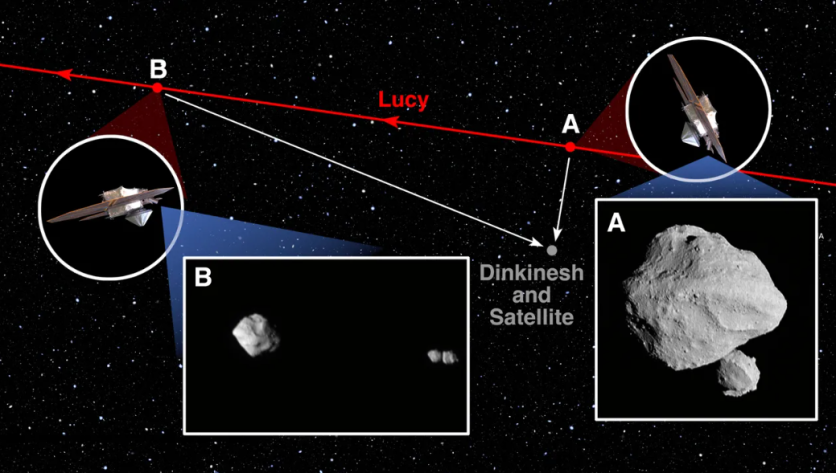NASA's Lucy mission has left astronomers astounded with its recent observations of the first-ever contact binary orbiting asteroid named Dinkinesh.
Initially, the discovery of Dinkinesh's satellite was intriguing in itself. But as data streamed in from the Lucy spacecraft's first encounter on November 1, scientists were taken aback to find that Dinkinesh's satellite itself is a contact binary, which is made of two smaller objects touching each other.

The 'So Bizarre' Asteroid Dinkinesh
The initial images received depicted the two lobes of the contact binary appearing to align, one behind the other, as seen from Lucy's vantage point. However, it was only with the subsequent images captured around the time of the encounter that the true nature of this celestial object was unveiled.
John Spencer, Lucy deputy project scientist at Colorado's Southwest Research Institute, noted that contact binaries appear to be fairly common in the solar system.
He explained, "We haven't seen many up-close, and we've never seen one orbiting another asteroid. We'd been puzzling over odd variations in Dinkinesh's brightness that we saw on approach, which gave us a hint that Dinkinesh might have a moon of some sort, but we never suspected anything so bizarre!"
While Lucy's primary mission is to survey Jupiter's Trojan asteroids, this unexpected encounter with a small, main belt asteroid was included in the mission in January to test the system's ability to continuously track and image the asteroids during high-speed flybys.
The success of this system at Dinkinesh allowed for multiple perspectives on the system, shedding light on the asteroids' shapes and leading to this startling revelation.
Hal Levison, principal investigator for Lucy, expressed his surprise, saying, "It is puzzling, to say the least... I would have never expected a system that looks like this. In particular, I don't understand why the two components of the satellite have similar sizes. This is going to be fun for the scientific community to figure out."
The second image, taken roughly six minutes after the closest approach from a distance of approximately 1,010 miles, documents the spacecraft's journey, covering about 960 miles between the two images.
NASA's Lucy Mission
Commenting on the discovery, Tom Statler, Lucy program scientist at NASA Headquarters in Washington, described it as a marvelous instance of nature presenting a new puzzle. He said that significant scientific endeavors like this lead "us to ask questions that we never knew we needed to ask."
"It's truly marvelous when nature surprises us with a new puzzle," he noted.
The team is processing the remaining encounter data from the spacecraft. Dinkinesh and its satellite mark the initial two of 11 asteroids slated for exploration during Lucy's 12-year expedition.
Following its passage along the inner edge of the primary asteroid belt, Lucy is presently set for a gravitational assist from Earth scheduled for December 2024.
This strategic maneuver will propel the spacecraft once more through the main asteroid belt for the observation of asteroid Donaldjohanson in 2025. Subsequently, Lucy will proceed with its mission to explore the Trojan asteroids in 2027.
Related Article : New Computer Simulation Sheds Light on Early Galaxy Formation Aligned With NASA James Webb's Observations

ⓒ 2025 TECHTIMES.com All rights reserved. Do not reproduce without permission.




